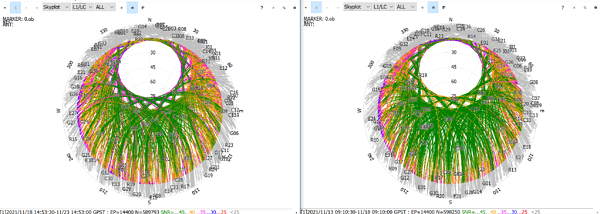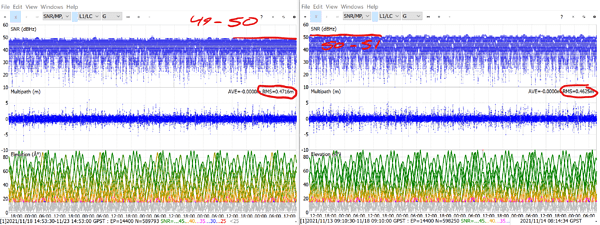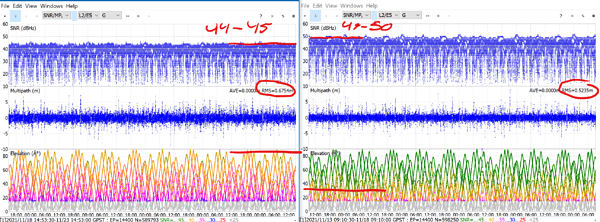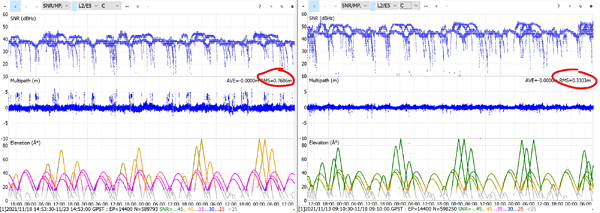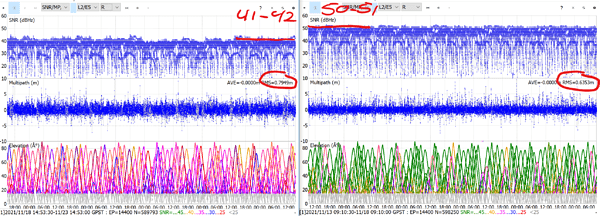The idea for this post came to me from seeing all the nice enclosures people are 3D-printing for their Emlid M2’s, using the drone helical antenna for keeping the size of the setup down.
I have seen numerous people claiming that the drone-antenna is just as good as a classic patch antenna for classic surveying on the ground. Looking at data-sheets and radiation plots it simply couldn’t be true.
So, what to do about that? Experiment of course!
For this experiment I have selected 2 antennas:
- Tallysman HC871
- Harxon/Swiftnav GPS500
They were chosen as they both are around 200 USD. The GPS500 antenna has the further advantage of being NGS calibrated.
I set up the antenna on a well-known and well-defined point at my home. The point that has low to medium multipath potential, with a roof to the east blocking the view up to 20 degrees. I have not elevated the antenna very much, again to make it a little tougher on the antennas for test-purposes.
Here the helical antenna mounted, rubber-band-style!
Let’s start with how the 2 antennas are different:
Tallysman HC871
This antennas is a helical design, which makes it quite compact. Doesn’t require a groundplane either (although it can benefit from one, but that will be a project for another day), which makes it super compact and lightweight, ideal for a drone.
On top of these advantages, it also allows for signals to enter from below 0 degrees, which is ideal on a drone that pitches and banks while in the air. Up high in the air, multipath issues are more or less non-existent anyway.
However, when used on the ground these advantages quickly becomes disadvantages. The disability to block signals from below becomes a problem. The lower gain of the antenna (~1.6 db) (partly from a missing groundplane) also becomes a problem, especially under less-than-ideal scenarios.
Datasheet: https://www.tallysman.com/app/uploads/2018/03/Tallysman®-HC871-Datasheet.pdf
Harxon/Swiftnav GPS500
So now to our second contender. The antenna is a patch design, a design used for GNSS since the very beginning. It consists of the antenna itself, on top of groundplane, usually 10-15 cm in diameter (but can be up to 40 cm on large choke ring geodetic antenna designs).
This antenna weighs in at almost 400 grams, making it 10 times as heavy as the helical.
However, the patch design makes it quite effective at stopping signals from below 0 degrees. It also feature much higher gain that the helical, at 5.5 db, further contributing to a better signal.
Many other parameters are also better, like the axial ratio (the ability to dampen signals with unwanted polarity).
Datasheet: https://www.swiftnav.com/resource-files/GNSS%20Antenna/v1.2/Specification/SwiftNav%20Mini%20Survey%20Antenna%20GPS500%20Specifications%20v1.2.pdf
So with that introduction, let us look at some hard data. For the 2 antennas I have collected raw-data for 5 consecutive days for each to make sure to have a good average.
Data was logged in UBX on the Emlid M2 and converted to Rinex 3.04 in RTKconv demo5_b34d using a 30 second interval, resulting in 14400 epochs each. Represented in RTKplot with a 15 deg mask (the grey area in the plots below).
Let’s look at the L1 band first (~1575-~1600 mhz) for all logged constellations, left HC871, right GPS500:
Almost identical! So if you where using the M+ you would notice little difference. The signal-to-noise ratio seems to drop off a little faster as we go from 90 deg to 0, as indicated by less green, going towards yellow.
Let’s focus on the L1 band but GPS only and another view:
We are here seeing 1-2 dbhz (Signal-to-Noise Ratio) less for max signal, and roughly similar multipath value. Insignificant difference in most regards.
So let’s do the same on the L2 band, (~1207 mhz - ~1278 mhz), left HC871, right GPS500:
Oh boy, what a difference! Much lower SNR!
Let’s try the alternative view from before to see more detail, but for L2 GPS, left HC871, right GPS500.
Around 5 dbhz of difference to the advantage of the GPS500 antenna, and significantly more multipath.
Let’s see what Beidou on L2 has to say, left HC871, right GPS500:
Here the difference in multipath is through the roof!
Finally, let’s look at Glonass at L2:
9 dbhz difference and also a significant difference in multipath.
Conclusion:
As with so many other tasks, it is all about choosing the right tool for the right job. Here it is clear to see that for ground-tasks, there are better alternatives to the helical. However, for drone RTK/PPK, the patch antenna design simply isn’t feasible due to size and weight.





